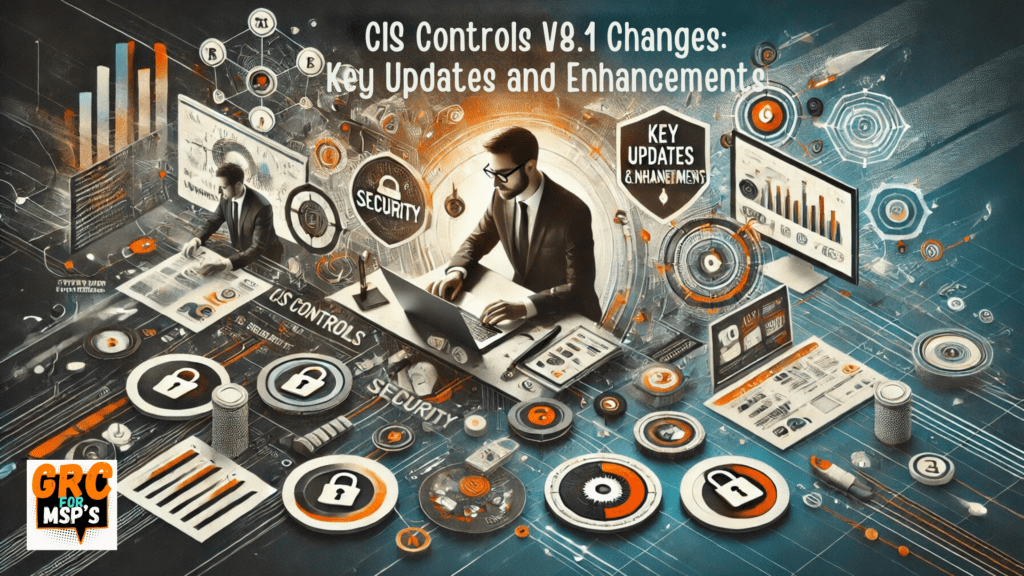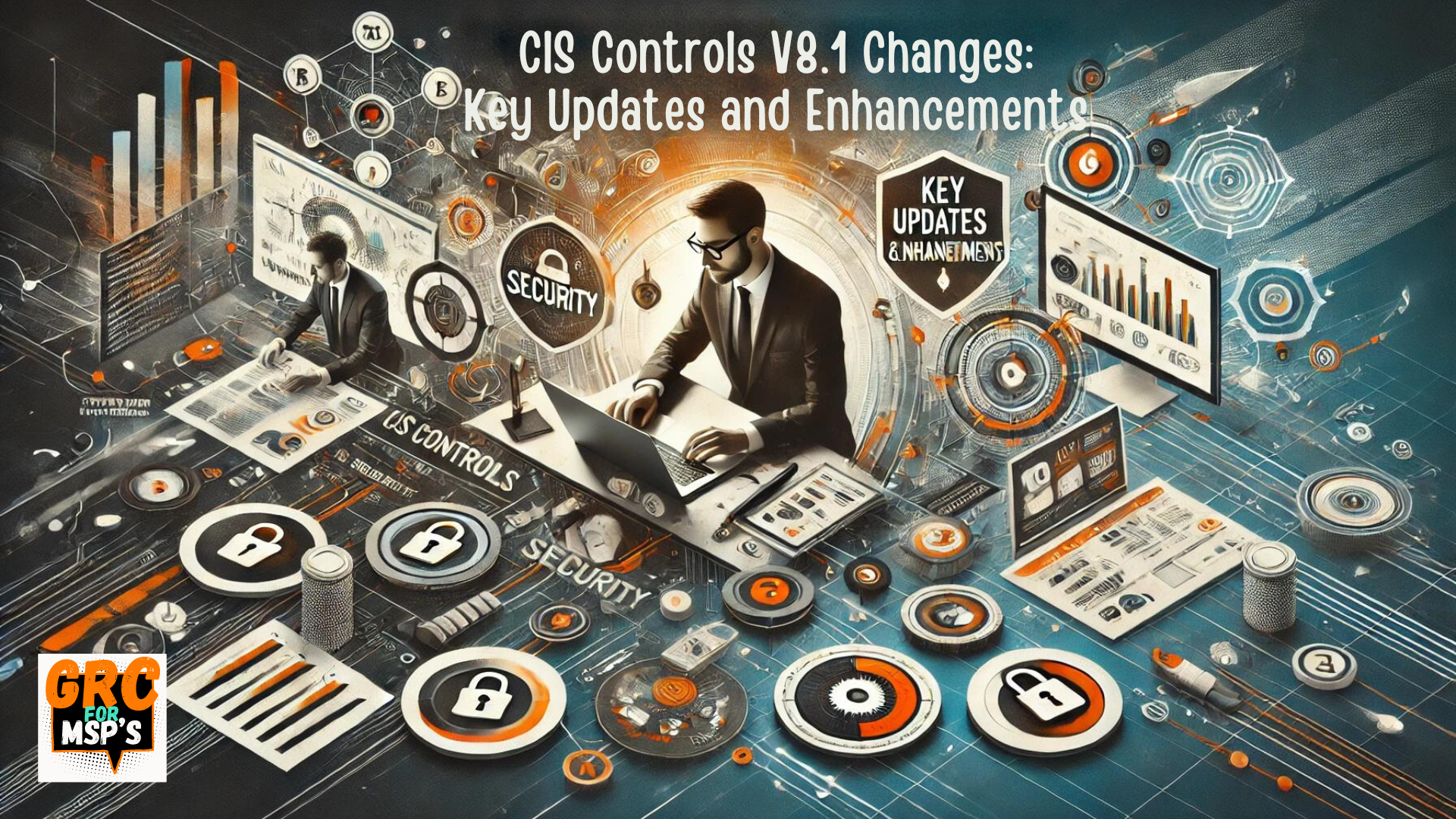CIS Controls Version 8.1 (v8.1) introduces several updates to enhance the cybersecurity standards that organisations rely on. One major change in v8.1 is the iterative update to existing controls, aimed at improving clarity and consistency. The changes are designed to minimise disruption while providing better tools and resources for effective implementation.

A significant addition in CIS Controls v8.1 is the updated alignment with evolving industry standards and frameworks. This includes revised asset classes and updated descriptions for safeguards. These revisions help organisations prioritise their security investments more efficiently and ensure they are prepared for emerging threats.
The updated version also brings new recommendations and tools to the CIS Governance function, which plays a crucial role in cybersecurity management. Organisations are encouraged to review these changes to better track, measure, and assess their cybersecurity posture, while also justifying investments in security practices more effectively.
Key Takeaways
- CIS Controls v8.1 enhances clarity and consistency for cybersecurity standards.
- It includes revised asset classes and updated safeguard descriptions.
- New governance recommendations and tools support better security practices.
Overview of CIS Controls Version 8.1
CIS Controls Version 8.1 introduces key updates and enhancements over previous versions, addressing modern cybersecurity challenges and improving the framework for organisations.
Evolution from Version 7.1
The transition from CIS Controls Version 7.1 to Version 8.1 involved significant restructuring. In Version 7.1, there were 20 controls, while Version 8 integrates them into 18 consolidated controls for better clarity and focus. This change was driven by the need to streamline and adapt to evolving cybersecurity threats, such as cloud computing and teleworking.
Furthermore, the safeguards in Version 8.1 have been prioritised based on the risk they mitigate. This shift helps organisations implement the most crucial security measures first, making it easier to defend against the most prevalent cyber-attacks. The move ensures that the controls remain relevant and actionable for various IT environments.
Key Updates and Enhancements
Version 8.1 introduces several important enhancements over its predecessor. One of the key updates is the emphasis on cloud security, recognising the widespread adoption of cloud services. The updated controls address both cloud-based and hybrid environments, ensuring comprehensive protection.
Another significant change is the incorporation of new safeguards that reflect modern threats and technologies. These include updated guidelines for mobile device management and remote work, recognising the shift towards more flexible working arrangements.
Additionally, CIS Controls Version 8.1 includes a refined mapping to industry standards. This mapping helps organisations ensure compliance with various legal, regulatory, and policy frameworks, making it easier to align security practices with broader business requirements.
Delineation of Implementation Groups
Implementation Groups (IGs) help organisations prioritise and manage their cybersecurity efforts. These groups, IG1, IG2, and IG3, are designed to meet different needs based on an organisation’s size, complexity, and risk profile.
Understanding IG1, IG2, and IG3

IG1 (Implementation Group 1) focuses on basic cyber hygiene. It includes 56 Safeguards that every enterprise should implement to protect their assets. These Safeguards are fundamental actions that provide a minimum level of security.
IG2 (Implementation Group 2) builds on IG1 by addressing additional risks faced by larger and more complex organisations. It includes all the Safeguards of IG1 plus an extra 74. This group aims to enhance security measures to protect more critical and sensitive data.
IG3 (Implementation Group 3) is for organisations with higher risk environments or handling highly sensitive information. It includes 153 Safeguards, encompassing all measures from IG1 and IG2 plus an additional 23. IG3 targets advanced threats and sophisticated attacks.
Organisational Application
Businesses should adopt the appropriate IG based on their specific needs. Small to medium enterprises typically start with IG1 to ensure they cover essential security measures. Larger enterprises with more complex operations might find IG2 more suitable, as it covers additional necessary protections.
High-risk industries, like finance or healthcare, often need the extensive coverage provided by IG3. They must secure sensitive personal data and financial information. Adopting IG3 helps in defending against sophisticated cyber threats.
Applying these Implementation Groups enables organisations to systematically improve their security posture and allocate resources efficiently. Each group ensures that key aspects of cybersecurity are addressed based on the organisation’s risk level and operational complexity.
Revised Safeguards and Controls
The CIS Controls V8.1 introduces notable updates to safeguards and controls, aimed at enhancing cybersecurity measures. These changes focus on helping organisations prioritise their implementation and utilise appropriate tools and solutions effectively.
Prioritised Approach for Implementation
CIS Controls V8.1 emphasises a prioritised approach to implementing safeguards. This means organisations can focus first on the most critical and effective measures. The update establishes clear priorities for cybersecurity tasks, allowing businesses to address the most pressing threats immediately.
By prioritising implementation, companies can allocate resources more efficiently. This approach helps mitigate prevalent cyber-attacks and enhances the overall security posture. CIS Controls V8.1 is particularly effective for tackling high-risk areas first, ensuring that vital security measures are not overlooked. More details on this approach can be found on the CIS Controls Version 8.1 page.
Toolsets and Solutions
The revision includes new and updated toolsets and solutions to support these safeguards. These tools help organisations implement security measures more effectively and efficiently. They range from software solutions for monitoring and enforcement to guidelines for physical security and access controls.
Organisations are encouraged to adopt these tools to enhance their ability to safeguard critical assets. Implementing these solutions as part of the CIS Controls framework can significantly reduce vulnerabilities. Specific examples of tools and solutions tailored for CIS Controls V8.1 are detailed further in the CIS Critical Security Controls v8.1 document.
Enhanced Security Practices
CIS Controls V8.1 includes updates that strengthen organisations’ abilities to handle cyber threats. This involves improving cyber hygiene, awareness, and advanced data protection methods.
Cyber Hygiene and Awareness
Effective cyber hygiene is crucial for maintaining a secure network. Organisations need to regularly update software and systems to defend against vulnerabilities. Training is essential in this context, ensuring employees recognise and avoid potential threats.
Service Provider Management is another key component. By working closely with service providers, organisations can ensure they follow best security practices and manage third-party risks.
Implementing strong password policies and multi-factor authentication increases security. Regular audits and monitoring help identify and address potential weaknesses promptly.
Advanced Threat and Data Protection
Advanced threat protection involves establishing robust malware defenses. This includes using antivirus software, firewalls, and intrusion detection systems. Keeping these tools updated is essential for defending against sophisticated cyber-attacks.
Organisations should implement encryption to secure sensitive data, both at rest and in transit. Regular backups are crucial for data recovery in case of a breach or loss.
Access controls are vital; they ensure that only authorised personnel can access sensitive information. Monitoring and logging all access activities provide a trail that can help in investigating incidents and improving systems.
By adopting these enhanced security practices, organisations can better protect their information and systems from evolving threats.
Guide to Organisational Adoption

Adopting CIS Controls V8.1 requires careful planning and strategic implementation to enhance an organisation’s cybersecurity posture. Key areas include defining roles and responsibilities and developing a tailored implementation strategy. These steps ensure consistent and effective application of security controls.
Roles and Responsibilities
Assigning clear roles and responsibilities is crucial. It begins with executive leadership, which prioritises cybersecurity and allocates necessary resources. Without commitment at this level, initiatives may lack the support needed for success.
IT managers oversee the implementation of security controls, coordinating efforts across departments. They ensure that the controls align with the organisation’s infrastructure and business processes. Security teams handle daily monitoring, threat detection, and incident response.
In addition, regular training for all employees fosters a culture of security awareness. This empowers staff to recognise and respond to potential threats, thereby reducing risk.
Developing a Customised Implementation Strategy
A customised implementation strategy ensures that security controls are effectively integrated into the organisation’s unique environment. Start by conducting a risk assessment to identify specific vulnerabilities and determine which controls are most critical.
Mapping to established frameworks like NIST CSF can provide a structured approach. This helps integrate CIS Controls with existing policies and procedures.
Next, develop a phased implementation plan. Prioritise controls that address the most significant risks first. By breaking the process into manageable stages, the organisation can allocate resources more efficiently.
Regular reviews and updates are essential. They ensure that security measures evolve alongside emerging threats and technological advancements, maintaining robust information security.
Frequently Asked Questions
This section addresses the key changes and enhancements in CIS Controls version 8.1, comparing it to prior versions and detailing new measures for information security.
What notable amendments have been introduced in the latest update to the CIS Controls?
The CIS Controls version 8.1 focuses on refining existing safeguards and adding new ones to address emerging threats. This includes streamlined processes and updated recommendations tailored to both cloud and hybrid environments.
How do the requirements in CIS Controls version 8 differ from those outlined in the previous version?
In version 8, there was a notable shift to include more cloud and virtualisation security measures. The structure was also simplified, reducing the number of controls from 20 to 18, to make implementation more straightforward and less complex.
Can you list the primary enhancements featured in version 8.1 of the CIS Controls?
Version 8.1 includes updates to better align with current regulatory frameworks. Improvements focus on addressing specific modern threats, refining the scope of each control, and ensuring compatibility with both new technologies and traditional IT environments. Find the detailed changes.
Where can one find a comprehensive list of the updated CIS Controls in a downloadable format?
A comprehensive list of the updated CIS Controls can be found on the CIS website. This resource provides a downloadable format for ease of access and implementation.
In regard to protecting information security, what new measures does the latest version of CIS Controls recommend?
The latest version recommends enhanced monitoring and response mechanisms, stronger encryption protocols, and methods for managing mobile and remote workforce security. These measures are designed to combat contemporary cyber threats effectively.
Which contemporary cyber threats are addressed by the alterations in the latest iteration of the CIS Controls?
The changes in the latest iteration address threats such as ransomware, phishing attacks, and advanced persistent threats (APTs). By focusing on these areas, CIS Controls v8.1 aims to reduce the risk of breaches and improve overall network security. Learn more about these updates.

